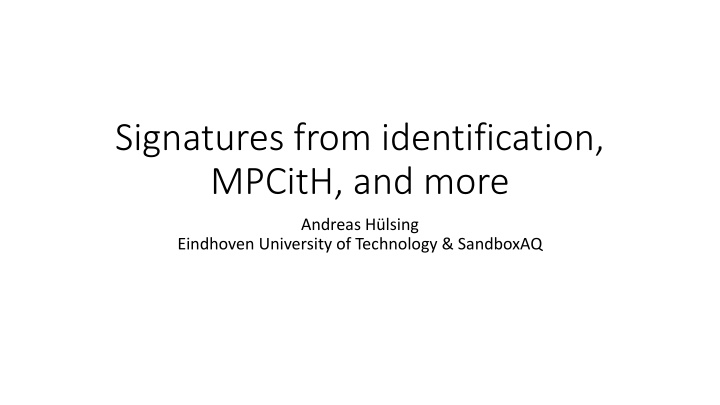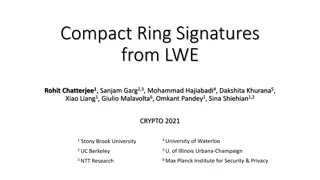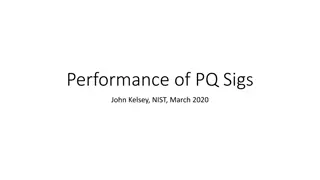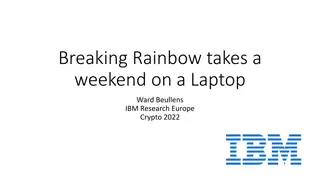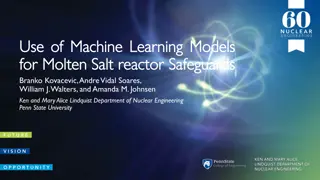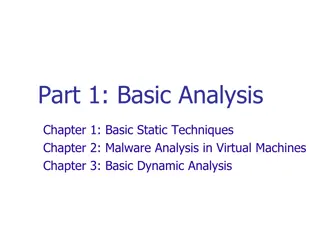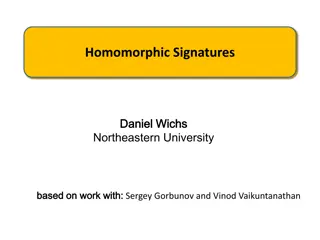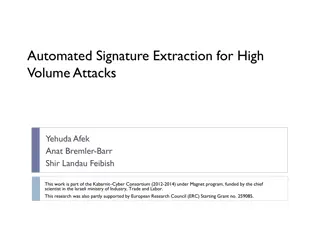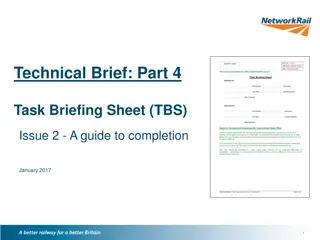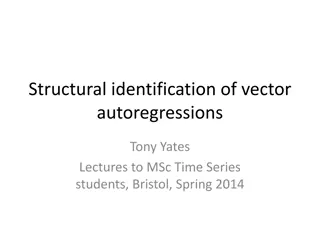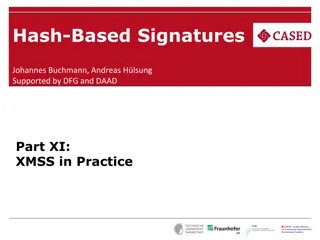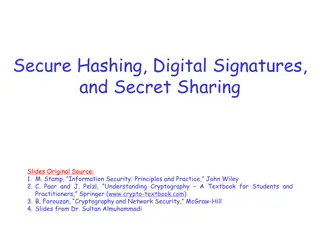Signatures from identification, MPCitH, and more
In cryptography, explore signatures from identification, MPCitH, and more approaches such as Fiat-Shamir and Syndrome Decoding. Learn about code-based signature schemes, OWF, encryption algorithms like AES, and the benefits of multi-party computation. Discover secure methods for joint function computation and how to achieve shorter signatures with zero-knowledge proofs.
Download Presentation

Please find below an Image/Link to download the presentation.
The content on the website is provided AS IS for your information and personal use only. It may not be sold, licensed, or shared on other websites without obtaining consent from the author.If you encounter any issues during the download, it is possible that the publisher has removed the file from their server.
You are allowed to download the files provided on this website for personal or commercial use, subject to the condition that they are used lawfully. All files are the property of their respective owners.
The content on the website is provided AS IS for your information and personal use only. It may not be sold, licensed, or shared on other websites without obtaining consent from the author.
E N D
Presentation Transcript
Signatures from identification, MPCitH, and more Andreas H lsing Eindhoven University of Technology & SandboxAQ
PQ Signatures Signatures vs KEM: Should be easier it isn't... Approaches: 1. Hash & Sign Full Domain Hash (FDH) with Trapdoor OWP: RSA-PSS, MAYO, UOV,... FDH with Preimage-sampleable TDF: Falcon Hash-based signatures 2. Signatures from identification: Fiat-Shamir (FS): (EC)DSA, Schnorr, FS with aborts: Dilithium FS + MPC in the Head (MPCitH): Picnic, Biscuit, MIRA, MiRitH, MQOM, PERK, RYDE, SDitH, AIMer, ... https://huelsing.net 2
Syndrome Decoding in the Head (FJR22) Code-based signature scheme using MPCitH Beats all previous code-based signatures Uses unstructured SD problem! Source: Thibauld Feneuil, Antoine Joux, and Matthieu Rivain. "Syndrome Decoding in the Head: Shorter Signatures from Zero- Knowledge Proofs". Crypto'22 https://huelsing.net 3
Outline OWF MPC P1([x]1) x = [x]1 + [x]2+ + [x]N F x y P5([x]5) P2([x]2) C([x]1, [x]2, , [x]N) = F(x) P4([x]4) P3([x]3) MPC in the Head DSig IDS Prover P (sk) Verifier V (pk) w w <- Commit(sk) Fiat-Shamir / SK PK c c <-R CSpace Sign Vrfy z z <- Response(sk,w,c) b <- Verify(pk,w,c,z) https://huelsing.net 4
Outline OWF MPC P1([x]1) x = [x]1 + [x]2+ + [x]N F x y P5([x]5) P2([x]2) C([x]1, [x]2, , [x]N) = F(x) P4([x]4) P3([x]3) MPC in the Head DSig IDS Prover P (sk) Verifier V (pk) w w <- Commit(sk) Fiat-Shamir / SK PK c c <-R CSpace Sign Vrfy z z <- Response(sk,w,c) b <- Verify(pk,w,c,z) https://huelsing.net 5
OWF AES (FEAST) LowMC (Picnic) AIM (AIMer) Polynomial arithmetic & evaluation (SDitH) MQ equation system (Biscuit) OWF F x y Low multiplicative depth is an advantage! https://huelsing.net 6
MPC P1([x]1) P5([x]5) P2([x]2) P4([x]4) P3([x]3) (secure) Multi-Party Computation https://huelsing.net 7
MPC Allows N parties P1, ,PNwith inputs x1, , xN to jointly compute a function F(x1, , xN) = y such that all parties learn the outcome y but nothing beyond that MPC P1([x]1) P5([x]5) P2([x]2) P4([x]4) P3([x]3) https://huelsing.net 8
Example: Price negotiations Buyer & Seller compute if they can agree on price X Logical AND of "willingness" If you do not agree, you do not learn the other party's decision! Prevents pushing up / down to limit of other party https://huelsing.net 9
MPC Allows N parties P1, ,PNwith inputs x1, , xN to jointly compute a function F(x1, , xN) = y such that all parties learn the outcome y but nothing beyond that We additionally need: Correctness: If all parties are honest, the result is correct N-1 private: If N-1 parties collaborate, they can still not learn anything about the input of the last party beyond what can be derived from F(x1, , xN) = y Broadcast communication: All messages are broadcasted https://huelsing.net 10
(additive) Secret Sharing Scheme (SSS) Split x = [x]1 + [x]2+ + [x]Nwith secret shares [x]i in Fq Given all but one share x is information theoretically hidden! https://huelsing.net 11
MPC for additive SSS Split x = [x]1 + [x]2+ + [x]Nwith secret shares [x]i in Fq Party i holds share [x]i of value x. Operations: Adding shared values ([x] + [y]): Parties locally add shares ([x]i+[y]i) = [x]i+ [y]i = x+y Adding constant ([x] + c): P1 computes [x]1+ c, all others do nothing [x]1+ c + [x]2+ + [x]N = [x]i+ c = x + c Multiplication by constant ([x] c): All parties locally compute [x]i c [x]1 c + [x]2 c + + [x]N c = ([x]1+ [x]2+ + [x]N) c = x c https://huelsing.net 12
MPC for additive SSS Split x = [x]1 + [x]2+ + [x]Nwith secret shares [x]i in Fq Party i holds share [x]i of value x. Operations: Adding shared values ([x] + [y]): Parties locally add shares ([x]i+[y]i) = [x]i+ [y]i = x+y Adding constant ([x] + c): P1 computes [x]1+ c, all others do nothing [x]1+ c + [x]2+ + [x]N = [x]i+ c = x + c Multiplication by constant ([x] c): All parties locally compute [x]i c [x]1 c + [x]2 c + + [x]N c = ([x]1+ [x]2+ + [x]N) c = x c Multiplication of shared values? https://huelsing.net 13
Share multiplication Conventional: (Katz, Kolesnikov, Wang. "Improved non-interactive zero knowledge with applications to post-quantum signatures". CCS 2018) All parties know one share of both inputs After protocol, all parties know a share of the output Modern: (Lindell, Nof. "A framework for constructing fast MPC over arithmetic circuits with malicious adversaries and an honest-majority". CCS 2017) (Baum, Nof. "Concretely-Efficient Zero-Knowledge Arguments for Arithmetic Circuits and Their Application to Lattice- Based Cryptography". PKC 2020) All parties know a share of both inputs and the output Protocol proves that output is a sharing of product of input https://huelsing.net 14
Verifying multiplication Parties need random triple [a], [b], [c], with ab = c, to verify [x], [y], [z], with xy = z Take random element e in Fq Parties locally set [ ] = e[x] + [a] and [ ] = [y] + [b] Parties broadcast [ ] and [ ] shares to open and Parties locally set [v] = e[z] [c] + [b] + [a] (note that last summand is only subtracted by P1) Parties broadcast [v] shares to open v and accept if v = 0. https://huelsing.net 15
Verifying multiplication Correctness v = e z c + b + a = e xy ab + (e x + a)b + (y + b)a (e x + a)(y + b) = exy ab + exb + ab + ya + ba exy exb ay ab = 0 https://huelsing.net 16
Verifying multiplication Soundness v = e z c + b + a = e xy ab + (e x + a)b + (y + b)a (e x + a)(y + b) = exy ab + exb + ab + ya + ba exy exb ay ab = 0 https://huelsing.net 17
Verifying multiplication Soundness Let z = xy + dz and c = ab + dc v = e z c + b + a = e xy + edz ab dc+ (e x + a)b + (y + b)a (e x + a)(y + b) = 0 + edz dc https://huelsing.net 18
Verifying multiplication Soundness Claim: If dz 0 or dc 0 then v = 0 with probability at most 1 / |Fq| Proof: Recall v = edz dc Case dz= 0 & dc 0: v = edz dc= - dc 0 https://huelsing.net 19
Verifying multiplication Soundness Claim: If dz 0 or dc 0 then v = 0 with probability at most 1 / |Fq| Proof: Recall v = edz dc Case dz= 0 & dc 0: v = edz dc= - dc 0 Case dz 0 & dc 0: v = 0 <=> dc = edz <=> dcdz-1= e (prob 1 / |Fq|) https://huelsing.net 20
Verifying multiplication Soundness Claim: If dz 0 or dc 0 then v = 0 with probability at most 1 / |Fq| Proof: Recall v = edz dc Case dz= 0 & dc 0: v = edz dc= - dc 0 Case dz 0 & dc 0: v = 0 <=> dc = edz <=> dcdz-1= e (prob 1 / |Fq|) Case dz 0 & dc= 0: v = edz dc= edz => v = 0 iff e = 0 (prob 1 / |Fq|) https://huelsing.net 21
Function to circuit - Examples Evaluating shared polynomial [P] = [pi] xiat public point r: Locally: [P](r) = [pi] ri = [y] No interaction Single secret shared value as outcome Evaluating product of shared polynomials [P], [S] at public point r: Requires knowledge of result [z] Locally: [P](r) = [pi] ri= [y], [S](r) = [si] ri= [x] Run verify for [x] [y] = [z] Single broadcast interaction + final opening https://huelsing.net 22
Function to circuit: SDitH (FJR'22) Turn Syndrome Decoding function into MPC https://huelsing.net 23
Function to circuit: SDitH (FJR'22) Turn Syndrome Decoding function into MPC Advantage: Linear function. https://huelsing.net 24
Function to circuit: SDitH (FJR'22) Turn Syndrome Decoding function into MPC Advantage: Linear function. Disadvantage: Weight check. https://huelsing.net 25
SDitH Implicit Equation Check Use H in standard form: H = (H' | Im-k) Can write x = (xA | xB) with y = H'xA + xB Define sk = xA Compute x via xB = y H'xA => guarantees x fulfills y = Hx https://huelsing.net 26
SDitH Weight check Compute x from xA, H, and y Derive a polynomial S from x Generate polys Q, P, and public F such that SQ PF = 0 if wt(x) Select t random points ri and verify that S(ri)Q(ri) = PF(ri) for 0 < i t. https://huelsing.net 27
SDitH MPC circuit Compute [x] from [xA], H, and y (only linear ops) Derive share of polynomial [S] from [x] (only linear ops) Generate secret shared polys [Q], [P], and public F such that [S][Q] [P]F = 0 if wt(x) Get t random points ri, t random masks ei, and run verification for [S](ri)[Q](ri) = [P]F(ri) using ei for 0 < i t. https://huelsing.net 28
IDS Prover P (sk) Verifier V (pk) w w <- Commit(sk) c c <-R CSpace z z <- Response(sk,w,c) b <- Verify(pk,w,c,z) Identification Schemes https://huelsing.net 29
Identification Schemes (IDS) / Zero-knowledge proofs (ZKP) Invented by Shafi Goldwasser, Silvio Micali and Charles Rackoff in 1985 Interactive proof systems Prove knowledge of a secret without revealing any information about the secret [For people that like classifications: The IDS we discuss are actually Honest-Verifier Zero-Knowledge Arguments of Knowledge] https://huelsing.net 30
Identification schemes(3-round, public coin) Prover P (sk) Verifier V (pk) w w <- Commit(sk) c c <-R CSpace z <- Response(sk,w,c) z b <- Verify(pk,w,c,z) Also called a "Sigma Protocol" https://huelsing.net 31
The case of Sudoku A: I have a nice Sudoku for you B: You are sure this is solvable? A: Sure! B: Prove it! A: Ok... 5 3 4 6 7 8 9 1 2 6 7 2 1 9 5 3 4 8 1 9 8 3 4 2 5 6 7 8 5 9 7 6 1 4 2 3 4 2 6 8 5 3 7 9 1 7 1 3 9 2 4 8 5 6 9 6 1 5 3 7 2 8 4 2 8 7 4 1 9 6 3 5 3 4 5 2 8 6 1 7 9 https://huelsing.net 32
The case of Sudoku So how can Alice prove that a solution exists without making the Sudoku easier (a.k.a. leaking information)? https://huelsing.net 33
The case of Sudoku Apply random permutation to solution: 1 2 3 4 5 6 7 8 9 3 2 7 1 6 9 4 5 8 5 3 4 6 7 8 9 1 2 6 7 2 1 9 5 3 4 8 1 9 8 3 4 2 5 6 7 6 7 1 9 4 5 8 3 2 9 4 2 3 8 6 7 1 5 3 8 5 7 1 2 6 9 4 8 5 9 7 6 1 4 2 3 4 2 6 8 5 3 7 9 1 7 1 3 9 2 4 8 5 6 5 6 8 4 9 3 1 2 7 1 2 9 5 6 7 4 8 3 4 3 7 8 2 1 5 6 9 9 6 1 5 3 7 2 8 4 2 8 7 4 1 9 6 3 5 3 4 5 2 8 6 1 7 9 8 9 3 6 7 4 2 5 1 2 5 4 1 3 8 9 7 6 7 1 6 2 5 9 3 4 8 https://huelsing.net 34
The case of Sudoku Prepare scratch card: 6 7 1 9 4 5 8 3 2 9 4 2 3 8 6 7 1 5 3 8 5 7 1 2 6 9 4 5 6 8 4 9 3 1 2 7 1 2 9 5 6 7 4 8 3 4 3 7 8 2 1 5 6 9 8 9 3 6 7 4 2 5 1 2 5 4 1 3 8 9 7 6 7 1 6 2 5 9 3 4 8 https://huelsing.net 35
The case of Sudoku Show scratch card to Bob and allow him to ask Alice to do one out of the following: Scratch off a row Scratch off a column Scratch off a square Scratch off original Sudoku 6 7 1 9 4 5 8 3 2 9 4 2 3 8 6 7 1 5 3 8 5 7 1 2 6 9 4 5 6 8 4 9 3 1 2 7 1 2 9 5 6 7 4 8 3 4 3 7 8 2 1 5 6 9 8 9 3 6 7 4 2 5 1 2 5 4 1 3 8 9 7 6 7 1 6 2 5 9 3 4 8 https://huelsing.net 36
The case of Sudoku What does Bob gain? (Soundness) If scratching reveals inconsistency: Alice cheated! If scratching reveals consistent values: Alice might have cheated... But Bob gains some confidence in Alice knowing a solution. https://huelsing.net 37
The case of Sudoku Bob choose from 28 possible challenges 1 28 If Alice is cheating she gets caught with prob. Cheating Alice has chance of 27 28 to succeed Repeating protocol ?times means Alice s cheating probability goes down to ? 0.05? 27 28 1 2 When ? = 2500, Alice caught with 0.99 probability. https://huelsing.net 38
The case of Sudoku (Honest-Verifier) Zero-knowledge: We want to show that (honest) Bob does not learn anything about the secret (i.e., the Sudoku solution) We will prove: Everything he learns, he could have generated himself. Can be proved showing that Bob (without knowing the secret) could have generated valid protocol transcripts that are indistinguishable from those obtained by communicating with Alice. ? ? https://huelsing.net 39
The case of Sudoku Proving zero-knowledge: Trick: When Bob generates transcripts, he can first select the challenge, then produce the scratch card! For challenge row, column, or square: Just put random permutation of 1...9. For challenge original Sudoku: Just put random permutation of the used numbers. Follows exactly same distribution as what Alice would have put there! https://huelsing.net 40
The case of Sudoku - Implications Yato 2003: Solvability of n x n Sudoku is NP-complete We can use this proof for any other problem in NP Just transform problem instance into Sudoku instance and run ZKP for that instance. https://huelsing.net 41
Identification schemes(3-round, public coin) Prover P (sk) Verifier V (pk) w w <- Commit(sk) c c <-R CSpace z <- Response(sk,w,c) z b <- Verify(pk,w,c,z) Also called a "Sigma Protocol" https://huelsing.net 42
Security Properties Soundness: A prover that does not know the secret will get caught with high probability (1 e) where e is called soundness error Special soundness: There exists an efficient extractor E that given two transcripts with same w but different c, extracts sk. Honest verifier zero-knowledge (HVZK): There exists an efficient simulator S that, given only the public key, outputs transcripts which are indistinguishable from transcripts of honest protocol runs https://huelsing.net 43
Identification schemes(5-round, public coin) Prover P (sk) Verifier V (pk) w w <- Commit(sk) c1 c1 <-R CSpace1 z1 <- Response(sk,w,c1) z1 c2 c2 <-R CSpace2 z2 <- Response(sk,w,c1,z1,c2) z b <- Verify(pk,w,c1,z1,c2,z2) https://huelsing.net 44
More notes on IDS We can have 2n+1 round IDS for n 1 We usually require that w has high entropy (hard to predict) Commitment-recoverable IDS: There exist function Recv(c, z) -> w We later need negligible soundness error Achieved via parallel composition https://huelsing.net 45
MPC P1([x]1) P5([x]5) P2([x]2) P4([x]4) P3([x]3) MPC in the Head IDS Prover P (sk) Verifier V (pk) MPC in the Head w w <- Commit(sk) c c <-R CSpace Y. Ishai, E. Kushilevitz, R. Ostrovsky, and A. Sahai. Zero-knowledge from secure multiparty computation . STOC'07 z z <- Response(sk,w,c) b <- Verify(pk,w,c,z) 46 https://huelsing.net 46
MPCitH for PQ-identification (Y. Ishai, E. Kushilevitz, R. Ostrovsky, and A. Sahai. Zero-knowledgefrom secure multiparty computation . STOC'07) Given OWF F: X -> Y Create identification scheme IDS that proves knowledge of x such that F(x) = y for given y in (honest-verifier) zero-knowledge. sk = x, pk = y[, F] https://huelsing.net 47
High-level idea Prover P (sk) Verifier V (pk) P1([x]1) P5([x]5) P2([x]2) w P4([x]4) P3([x]3) w <- Commit([x]), c c <-R{1, , 5} z z <- Pi forall i c Check consistency of all opened parties & verify result https://huelsing.net 48
Security - Soundness Prover P (sk) Verifier V (pk) P1([x]1) P5([x]5) P2([x]2) w P4([x]4) P3([x]3) w <- Commit([x]), c c <-R{1, , 5} z z <- Pi forall i c Check consistency of all opened parties & verify result https://huelsing.net 49
Security - Soundness Prover P (sk) Verifier V (pk) P1([x]1) P5([x]5) P2([x]2) w P4([x]4) P3([x]3) w <- Commit([x]), c = 4 c <-R{1, , 5} z z <- Pi for i 4 Check consistency of all opened parties & verify result https://huelsing.net 50
